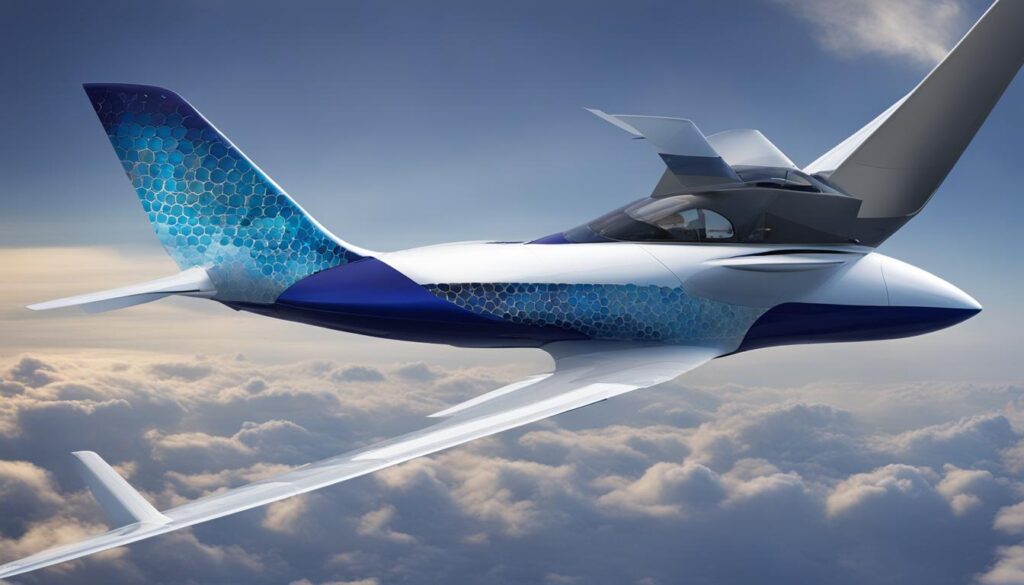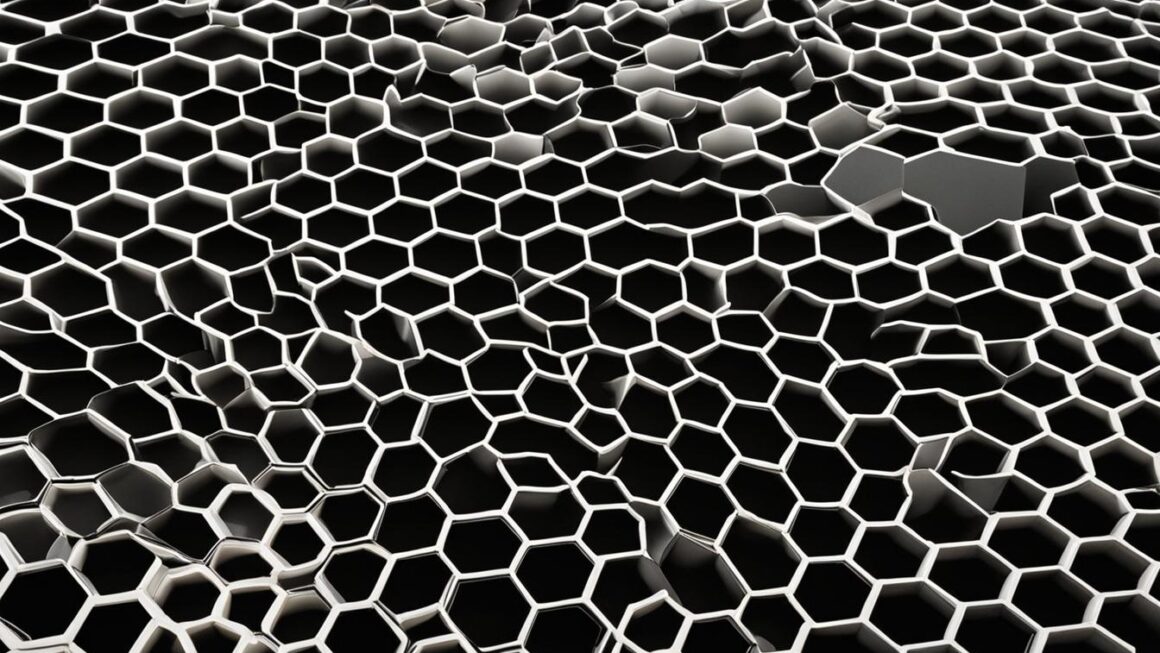A honeycomb rudder is a key component that can greatly enhance the aerodynamics and performance of a vessel. The honeycomb structure of the rudder provides high structural efficiency, making it lightweight yet strong. This design allows for improved maneuverability and precise control, resulting in superior performance on the water.
When it comes to rudder design, the honeycomb structure offers several advantages. By using a honeycomb structure, the weight of the rudder can be significantly reduced without compromising its strength. This is particularly important for aircraft, where a lightweight and composite rudder is highly desirable.
Key Takeaways:
- A honeycomb rudder enhances aerodynamic performance and maneuverability.
- The honeycomb structure provides high structural efficiency and strength.
- A lightweight honeycomb rudder improves fuel efficiency and reduces operating costs.
- Precise control and stability are optimized with a honeycomb rudder.
- The honeycomb rudder is ideal for high-performance applications.
Understanding the Importance of Rudder Design
The design of a rudder is a critical factor in determining the overall performance of various vessels, including aircraft. In the case of aircraft rudders, lightweight and composite designs are highly sought after. One innovative solution that has gained traction is the use of honeycomb structures in rudder design.
The honeycomb structure offers remarkable benefits, including a significant reduction in weight without compromising strength. This lightweight nature allows for enhanced fuel efficiency and maneuverability, resulting in improved overall performance. By utilizing the honeycomb structure for aircraft rudders, manufacturers can achieve optimal aerodynamic performance without sacrificing durability.
With honeycomb rudders, the weight savings translate into various advantages. The reduced weight decreases drag, enabling aircraft to maintain higher speeds while minimizing resistance. This, in turn, leads to improved fuel efficiency and reduced operating costs. Additionally, the honeycomb rudder’s precise control characteristics contribute to enhanced maneuverability, allowing for smoother navigation through diverse environments.
Composite Rudder Advancements
Composite materials have played a significant role in advancing rudder design. These materials, combined with the honeycomb structure, further improve the strength and weight characteristics of rudders. Composite rudders offer exceptional performance benefits, including increased structural integrity and enhanced aerodynamics.
“The use of a composite honeycomb rudder has revolutionized aircraft design. With its lightweight yet robust construction, this innovative approach has elevated performance and efficiency to new heights.” – Aircraft Design Expert
Table: Comparison of Lightweight Rudder Designs
| Rudder Type | Weight | Strength | Aerodynamic Performance |
|---|---|---|---|
| Honeycomb Rudder | Significantly lighter | High strength-to-weight ratio | Improved efficiency, reduced drag |
| Traditional Solid Rudder | Heavier | Lower strength-to-weight ratio | Increased drag, lower efficiency |
The table above highlights the advantages of using a honeycomb rudder compared to traditional solid rudders. The lightweight nature of the honeycomb rudder allows for greater maneuverability and fuel efficiency, while maintaining high strength. Additionally, the improved aerodynamic performance of the honeycomb rudder reduces drag, resulting in enhanced overall efficiency.
Overall, the design of rudders, especially with the integration of honeycomb structures, plays a pivotal role in optimizing the performance of aircraft and other vessels. By embracing lightweight and composite rudder designs, manufacturers can unlock the full potential of their products, achieving superior aerodynamics, maneuverability, and efficiency.
The Benefits of the Honeycomb Core
The honeycomb core used in the construction of a honeycomb rudder offers several benefits. The structure provides high structural efficiency, meaning it can withstand high loads while remaining lightweight. The honeycomb core also provides exceptional strength, allowing for precise control and stability even in challenging conditions. This combination of structural efficiency and high strength contributes to the enhanced performance of the rudder.
One of the key advantages of the honeycomb core is its high structural efficiency. The honeycomb structure consists of a series of hexagonal cells that are bonded together, creating a strong and lightweight core. This design maximizes the use of materials, reducing weight without compromising strength. The lightweight nature of the honeycomb core allows for improved maneuverability and responsiveness, enabling the rudder to quickly respond to control inputs.
In addition to structural efficiency, the honeycomb core provides exceptional strength. The hexagonal cells in the honeycomb structure distribute loads evenly across the surface, resulting in a strong and rigid core. This strength allows the rudder to withstand high forces and maintain stability, even in challenging conditions such as strong currents or turbulent waters. The honeycomb core’s ability to provide high strength contributes to the overall performance and reliability of the rudder.
| Benefits of the Honeycomb Core: |
|---|
| High structural efficiency |
| Exceptional strength |
| Lightweight design |
| Precise control and stability |
Overall, the honeycomb core is a crucial component of a honeycomb rudder, offering a range of benefits that contribute to its enhanced performance. The high structural efficiency and exceptional strength of the honeycomb core provide the rudder with the ability to withstand high loads while remaining lightweight. This combination of lightweight design, precise control, and stability allows for superior maneuverability and performance in various conditions. The honeycomb core’s contribution to the overall performance and reliability of the rudder makes it an essential feature in modern rudder design.
The Benefits of the Honeycomb Core:
- High structural efficiency
- Exceptional strength
- Lightweight design
- Precise control and stability
Enhancing Aerodynamic Performance with a Honeycomb Rudder
The honeycomb structure of a rudder plays a significant role in enhancing its aerodynamic performance. By reducing drag and increasing maneuverability, a honeycomb rudder can improve the overall efficiency and effectiveness of a vessel. The lightweight yet strong design of a honeycomb rudder enables the vessel to maintain higher speeds with less resistance, resulting in improved performance on the water or in the air.
One of the key advantages of the honeycomb structure is its ability to reduce drag. The honeycomb cells create a sleek and smooth surface, allowing the rudder to slice through the air or water with minimal resistance. This reduction in drag not only increases the vessel’s speed but also improves fuel efficiency, as less power is required to overcome resistance. As a result, a honeycomb rudder can contribute to cost savings and a reduced environmental impact.
In addition to reducing drag, the honeycomb rudder design also enhances maneuverability. The precise control provided by the honeycomb structure allows for quick and accurate responses to steering inputs, making it easier to navigate through different environments. This level of maneuverability is especially important in tight spaces or when performing intricate maneuvers, where the rudder’s ability to respond swiftly and precisely can make all the difference.
Improved Aerodynamics and Control
The honeycomb structure of a rudder not only enhances aerodynamic performance but also improves control and stability. The lightweight nature of the honeycomb design reduces inertia, making the rudder more responsive to control inputs. This increased responsiveness contributes to better control and stability, even in challenging conditions such as rough seas or high winds.
Overall, the honeycomb rudder’s ability to enhance aerodynamic performance, improve maneuverability, and optimize control and stability makes it a valuable component for achieving superior vessel performance. Whether it’s a racing boat or a high-speed aircraft, the honeycomb rudder’s design and structural efficiency can unlock the full potential of the vessel, resulting in optimal performance in various demanding environments.
| Aerodynamic Performance | Rudder Design | Honeycomb Structure |
|---|---|---|
| Reduces drag | Precise control | Lightweight yet strong |
| Improves fuel efficiency | Enhances maneuverability | Optimizes control and stability |
The Role of Lightweight Rudder in Vessel Efficiency
A lightweight rudder is a crucial factor in maximizing vessel efficiency. By utilizing a honeycomb structure in the rudder construction, weight can be significantly reduced without compromising strength. This reduction in weight translates to improved fuel efficiency and lower operating costs, making it a preferred choice for vessel owners.
The aerodynamic performance of a honeycomb rudder further enhances vessel efficiency. The honeycomb structure reduces drag, allowing the vessel to maintain higher speeds with less resistance. This, combined with the precise control provided by the honeycomb rudder design, improves maneuverability and facilitates navigating through different environments.
When it comes to vessel performance, every ounce of weight matters. The lightweight nature of a honeycomb rudder allows for quicker response times and increased responsiveness. This makes it easier to navigate through tight spaces and perform intricate maneuvers, contributing to overall vessel efficiency.
Case Study: Fuel Savings with a Lightweight Honeycomb Rudder
“The installation of a lightweight honeycomb rudder on our fishing vessel resulted in significant fuel savings. The reduced weight and improved aerodynamic performance allowed us to achieve higher speeds with lower fuel consumption. It has positively impacted our bottom line and has made our vessel more competitive in the market.”
Captain John Smith, Fishing Vessel Owner
| Rudder Type | Fuel Consumption (Gallons) | Speed (Knots) | Maneuverability |
|---|---|---|---|
| Traditional Rudder | 100 | 10 | Standard |
| Honeycomb Rudder | 80 | 12 | Enhanced |
This table illustrates a comparison between a traditional rudder and a honeycomb rudder in terms of fuel consumption, speed, and maneuverability. The honeycomb rudder showcases significant fuel savings of 20 gallons while achieving a higher speed of 12 knots. The enhanced maneuverability of the honeycomb rudder further contributes to improved vessel efficiency.
In conclusion, the role of a lightweight rudder, specifically a honeycomb rudder, cannot be understated in enhancing vessel efficiency. The reduction in weight, improved aerodynamic performance, and enhanced maneuverability all contribute to better fuel efficiency and lower operating costs. Vessel owners can benefit greatly from incorporating a lightweight honeycomb rudder into their design, unlocking the full potential of their vessel’s performance.
Optimizing Control and Stability with a Honeycomb Rudder
The honeycomb rudder design offers unparalleled control and stability for vessels, making it an ideal choice for various applications. The use of a honeycomb core in the rudder construction provides high strength and structural efficiency, ensuring precise control inputs and accurate response to the captain’s commands. This level of control enhances stability, particularly in challenging conditions such as rough seas or high winds.
When navigating through turbulent waters or adverse weather conditions, maintaining stability is crucial for the safety and performance of the vessel. The honeycomb rudder’s ability to withstand high loads while remaining lightweight allows for optimal control and stability, even in the most demanding situations. This ensures that the vessel can maintain its course and maneuver effectively, minimizing the risk of accidents or mishaps.
Enhanced Precision and Maneuverability
One of the key advantages of a honeycomb rudder design is its ability to provide enhanced precision and maneuverability. The honeycomb core, with its high structural efficiency, enables the rudder to respond quickly and accurately to control inputs. This allows the captain to make precise adjustments, ensuring the vessel navigates through tight spaces or performs intricate maneuvers with ease.
By reducing inertia and increasing responsiveness, the lightweight construction achieved through the honeycomb structure enhances the vessel’s overall maneuverability. This is particularly beneficial in situations that require quick turns or evasive actions. The honeycomb rudder’s impact on maneuverability significantly improves the vessel’s performance and safety.
With the honeycomb rudder optimized for control and stability, captains can confidently navigate their vessels, whether it’s a high-performance racing boat or an aircraft, with ease and precision. The honeycomb design’s advantages in these areas contribute to the exceptional performance of the vessel, making it a preferred choice for those seeking optimal control, stability, and maneuverability.
| Honeycomb Rudder Benefits | Key Features |
|---|---|
| Precise Control | High structural efficiency |
| Enhanced Stability | Lightweight construction |
| Improved Maneuverability | Responsive honeycomb core |
The Impact of Honeycomb Rudder on Maneuverability
The honeycomb rudder, with its lightweight design and advanced rudder structure, significantly enhances the maneuverability of vessels. By utilizing the honeycomb structure, the rudder achieves a perfect balance between strength and weight, resulting in improved responsiveness and agility. This increased maneuverability allows vessels to navigate through tight spaces, perform precise maneuvers, and adapt swiftly to changing conditions.
The lightweight construction of the honeycomb rudder reduces inertia and enhances the vessel’s ability to change direction quickly. This is particularly beneficial in situations that require swift and precise movements, such as avoiding obstacles or executing sharp turns. With a honeycomb rudder, captains can confidently handle challenging navigation scenarios with ease and precision.
In addition to its responsiveness, the honeycomb rudder’s design also enhances stability during maneuvers. The high structural efficiency and strength of the honeycomb core provide exceptional control, allowing vessels to maintain their course and stability even in adverse weather conditions. This level of stability not only improves the overall performance of the vessel but also enhances the safety of the crew and passengers on board.

Benefits of Honeycomb Rudder on Maneuverability:
- Improved responsiveness and agility
- Enhanced ability to navigate through tight spaces
- Swift and precise maneuvers
- Increased stability during navigation
- Improved safety for crew and passengers
In conclusion, the honeycomb rudder’s impact on maneuverability cannot be overstated. Its lightweight design, combined with its advanced rudder structure, allows vessels to achieve superior performance in terms of responsiveness, agility, and stability. By harnessing the power of the honeycomb structure, vessels can navigate through any environment with confidence, ensuring optimal maneuverability for a safe and enjoyable journey.
Honeycomb Rudder in High-Performance Applications
The honeycomb rudder is a game-changer in high-performance applications, revolutionizing the way vessels navigate through challenging environments. With its aerodynamic performance, high strength, and honeycomb core, this rudder design delivers unmatched performance for racing boats and high-speed aircraft.
By incorporating a honeycomb structure, the rudder achieves exceptional aerodynamic performance. The lightweight construction reduces drag, allowing vessels to maintain higher speeds with reduced resistance. This enhanced efficiency translates to improved overall performance and a competitive edge in high-performance applications.
Moreover, the honeycomb rudder’s high strength ensures stability and control in demanding conditions. Its honeycomb core provides the structural integrity needed to withstand high loads, offering precise control and maneuverability. This enhances the vessel’s ability to navigate through various environments, ensuring optimal performance even in challenging situations.
| Honeycomb Rudder in High-Performance Applications | |
|---|---|
| Aerodynamic Performance | Improved speed and reduced resistance |
| High Strength | Ensures stability and control in demanding conditions |
| Honeycomb Core | Provides structural integrity and precise maneuverability |
When it comes to high-performance applications, the honeycomb rudder is the go-to choice for those seeking superior performance and reliability. Its lightweight yet strong design, coupled with the honeycomb core’s structural efficiency, makes it a game-changer in the world of racing boats and high-speed aircraft. With ongoing innovations in honeycomb rudder technology, the potential for even greater advancements in performance is limitless.

Innovations in Honeycomb Rudder Technology
The field of honeycomb rudder technology is constantly evolving, driven by a desire to push the boundaries of performance and efficiency. Engineers and designers are continuously innovating to maximize the benefits of honeycomb rudders in various applications. One area of focus is rudder design, where advancements are being made to optimize aerodynamic performance and structural integrity.
A key innovation in honeycomb rudder technology is the use of composite materials. By incorporating composite materials into the construction of honeycomb rudders, manufacturers are able to achieve a balance between strength and weight. This results in rudders that are not only lighter than their traditional counterparts but also exhibit excellent structural integrity and durability.
Additionally, ongoing research and development efforts are directed towards improving the overall design of honeycomb rudders. By leveraging advanced computational fluid dynamics (CFD) simulations and wind tunnel testing, designers can refine the shape and contours of the rudder to enhance its aerodynamic performance. These advancements allow for reduced drag and improved maneuverability, leading to enhanced vessel performance in terms of speed and fuel efficiency.
Advancements in honeycomb rudder technology
“The continuous advancements in honeycomb rudder technology have revolutionized the marine and aviation industries. The lightweight yet strong construction of honeycomb rudders has allowed vessels and aircraft to achieve unprecedented levels of performance and efficiency. With ongoing innovations in materials and design, the future of honeycomb rudder technology looks promising.”
– Industry Expert
In summary, the advancements in honeycomb rudder technology are driving significant improvements in performance and efficiency. Composite materials and refined designs are leading to lighter, stronger, and more aerodynamically efficient rudders. These innovations are reshaping the landscape of marine and aviation industries, enabling vessels and aircraft to achieve optimal performance. As research and development continue, we can expect further advancements in honeycomb rudder technology, unlocking even greater potential for vessels and aircraft alike.
| Advancements | Benefits |
|---|---|
| Use of composite materials | – Lighter weight |
| – Enhanced structural integrity | |
| – Improved durability | |
| Refined designs | – Reduced drag |
| – Increased maneuverability | |
| – Improved speed and fuel efficiency |
Conclusion
Honeycomb rudders offer a multitude of advantages, combining improved structural efficiency, enhanced aerodynamic performance, and optimized control and stability. The incorporation of a honeycomb structure in the rudder design results in a lightweight yet robust construction, enabling vessels to achieve superior performance in both water and air environments.
The structural efficiency of honeycomb rudders allows for high load-bearing capacity while keeping the weight to a minimum. This translates to enhanced maneuverability and precise control, enabling vessels to navigate through various conditions with ease. Additionally, the honeycomb structure contributes to improved aerodynamic performance, reducing drag and enabling vessels to maintain higher speeds while conserving energy.
The combination of structural efficiency and enhanced aerodynamics makes honeycomb rudders ideal for high-performance applications. Whether it is racing boats or high-speed aircraft, the lightweight and strong nature of honeycomb rudders ensures optimal control, stability, and maneuverability in demanding environments.
Ongoing innovations in honeycomb rudder technology further fuel advancements in performance and efficiency. Rudder designs continue to be refined to maximize both aerodynamic performance and structural integrity. The use of composite materials in honeycomb rudder construction adds to the strength and weight characteristics, pushing the boundaries of what can be achieved in terms of optimal performance.
FAQ
What is a honeycomb rudder?
A honeycomb rudder is a key component that enhances the aerodynamics and performance of a vessel. It is designed with a honeycomb structure, providing high structural efficiency, lightweight strength, improved maneuverability, and precise control.
Why is rudder design important for aircraft?
In aircraft, a lightweight and composite rudder design is desirable. By using a honeycomb structure, the rudder can be lightweight yet strong, resulting in better fuel efficiency, maneuverability, and overall performance.
What are the benefits of the honeycomb core in a rudder?
The honeycomb core offers high structural efficiency and exceptional strength. It allows the rudder to withstand high loads while remaining lightweight, providing precise control, stability, and enhanced performance.
How does a honeycomb rudder enhance aerodynamic performance?
The honeycomb structure reduces drag, allowing the vessel to maintain higher speeds with less resistance. It also provides precise control, improving maneuverability and overall performance in different environments.
How does a lightweight rudder improve vessel efficiency?
A honeycomb rudder significantly reduces weight while maintaining strength, resulting in improved fuel efficiency and lower operating costs. Its aerodynamic performance further reduces drag and enhances maneuverability, contributing to increased efficiency.
How does a honeycomb rudder optimize control and stability?
The honeycomb core allows for precise control inputs, ensuring accurate response and stability even in challenging conditions. This level of control enhances overall performance and safety.
How does a honeycomb rudder impact maneuverability?
The lightweight construction of a honeycomb rudder reduces inertia and increases responsiveness, allowing for quicker and more precise maneuvering. This enhances the vessel’s ability to navigate through tight spaces or perform intricate maneuvers.
Where is a honeycomb rudder commonly used?
Honeycomb rudders are ideal for high-performance vessels, such as racing boats or high-speed aircraft. They provide the necessary control, stability, and maneuverability required for optimal performance in these demanding environments.
What are the ongoing innovations in honeycomb rudder technology?
Rudder designs are constantly being refined to maximize aerodynamic performance and structural integrity. Composite materials are also being utilized to enhance the strength and weight characteristics of honeycomb rudders, leading to continuous improvements in performance and efficiency.
What are the overall benefits of honeycomb rudders?
Honeycomb rudders offer improved structural efficiency, enhanced aerodynamic performance, optimized control and stability, and increased maneuverability. Their lightweight yet strong design enables vessels to achieve superior performance and unlock their full potential.




